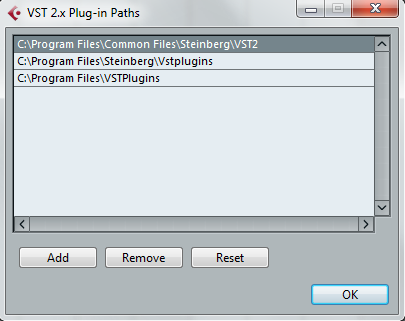VST Instruments come with a large number of VST presets for instant selection. Presets can either be accessed from the control panel for the instrument or from the Inspector.

How To Install Vst Plugins Into Cubase 5.0
In the “plugin” tab you have to select the VST folder of your plugins (1) then click on “ refresh plugin list” (2) Then, in “refresh plugin list” (a nice novelty of Fl Studio 12) you can add more files into the “scanner plugin” (plugin search paths add path). After installing a Toontrack plug-in you will need to let Cubase know where the new VST plug-in is installed. Depending on your operating system and the bitness of the plug-in, the location can be slightly different. The default install path for a Toontrack VST plug-in on 32-bit Windows is: C.
How To Install Vst Plugins In Cubase 5
To select a VST Instrument preset, proceed as follows:
1. Load a VST Instrument by creating an Instrument track.
2. If necessary, click on the track name at the top of the Inspector to open the basic track settings.
3. Click in the Programs field in the Inspector. This opens the Presets Browser. Selecting a new preset overwrites the settings of the current preset so any unsaved changes will be lost.
Steinberg Cubase Selecting VST Presets - Importing, Browsing, Exporting FXB Banks and FXP Presets (VST2 Plugins) Selecting VST presets. VST Instruments come with a large number of VST presets for instant selection. Presets can either be accessed from the control panel for the instrument or from the Inspector. Right-click on the Track list in Cubase and choose Add Instrument Track. From the context menu. In the Add Instrument Track window, open the Instrument drop-down menu and select the NI plug-in you wish to use. In our example, we select Massive. Click Add Track to create a new Instrument Track for MASSIVE. VST effect or VST instrument plug-ins normally have their own installation application. Read the documentation or readme files before installing new plug-ins. When you scan for newly installed plug-ins or relaunch Cubase, the new plug-ins are shown on the VST effect or VST. For Vst2 plugins, the V3 plugins’ names are like:AGM, AGT, AGL, ABU, ABA, AEU B. For Vst3 plugins, the V3 plugins’ names are like:Ample Guitar M C. In certain DAWs, such as Cubase, if both Vst2 and Vst3 plugins of the same instrument are installed, the DAW will display the Vst3 plugin. No idea what a PACE extension is, and as the system used to be stable, it makes no sense. If a VST, instrument or effect is unavailable, then the worst thing that happens is you get the 'cannot find' message - the tracks will load normally, but in the relevant box where you'd see the message about the plugin - it has!!!! Next to it showing it's missing.
4. To exit the browser, double-click the desired preset or click somewhere outside the window to close it.
• You can also open the preset list from the VST Instrument’s control panel. Simply click in the Preset name field.
• If you click the SoundFrame button (the cube symbol), the “Load Preset…” dialog opens.
This dialog is much like the Preset list, but there is a difference:

• If you use the “Load Preset” dialog, this allows you to preview the settings of other presets without actually loading them. If you chose to cancel the operation, the preset that was selected before opening the dialog will be reloaded
exactly as it was, including any unsaved changes. If you activate “Auto Preview” below the Viewer section, you can step through the presets and play them via MIDI.
• When you use the Preset list, selecting another preset will load it directly, replacing the previous preset.
• The Viewer section of the Load Preset dialog and the Preset list automatically display all the available presets for the instrument.
5. When you have selected an instrument preset, click OK to close the Load Preset dialog or – if you used the Preset browser – double-click the preset or click outside the browser window to close it.
Importing and converting FXB/FXP files

To import .fxp/.fxb files, proceed as follows:
1. Load any VST 2 instrument you may have installed, and click on the SoundFrame button to open the Preset Management pop-up menu.
2. Select “Import FXB/FXP” from the pop-up. This menu item is only available for VST 2 instrument plug-ins.
3. In the file dialog that opens, locate the file and click Open. If you loaded a Bank, it will replace the current set of all programs. If you loaded a single preset, it will replace the currently selected preset program only.
4. After importing, you can convert the current program list to VST Presets by selecting “Convert Program List to VST Presets” from the Preset Management pop-up. After converting, the presets will be available. The new converted presets will be stored in the VST3 Preset folder.
Steinberg Cubase (Magnus Choir older version) Importing FXB Banks and FXP Presets
(Note: Magnus Choirnewest version have a browser to select predefined sounds - presets)
Browsing FXB Banks and FXP Presets from a separated Full Bank or individual Presets.
(Also applicable for customized presets in these formats)